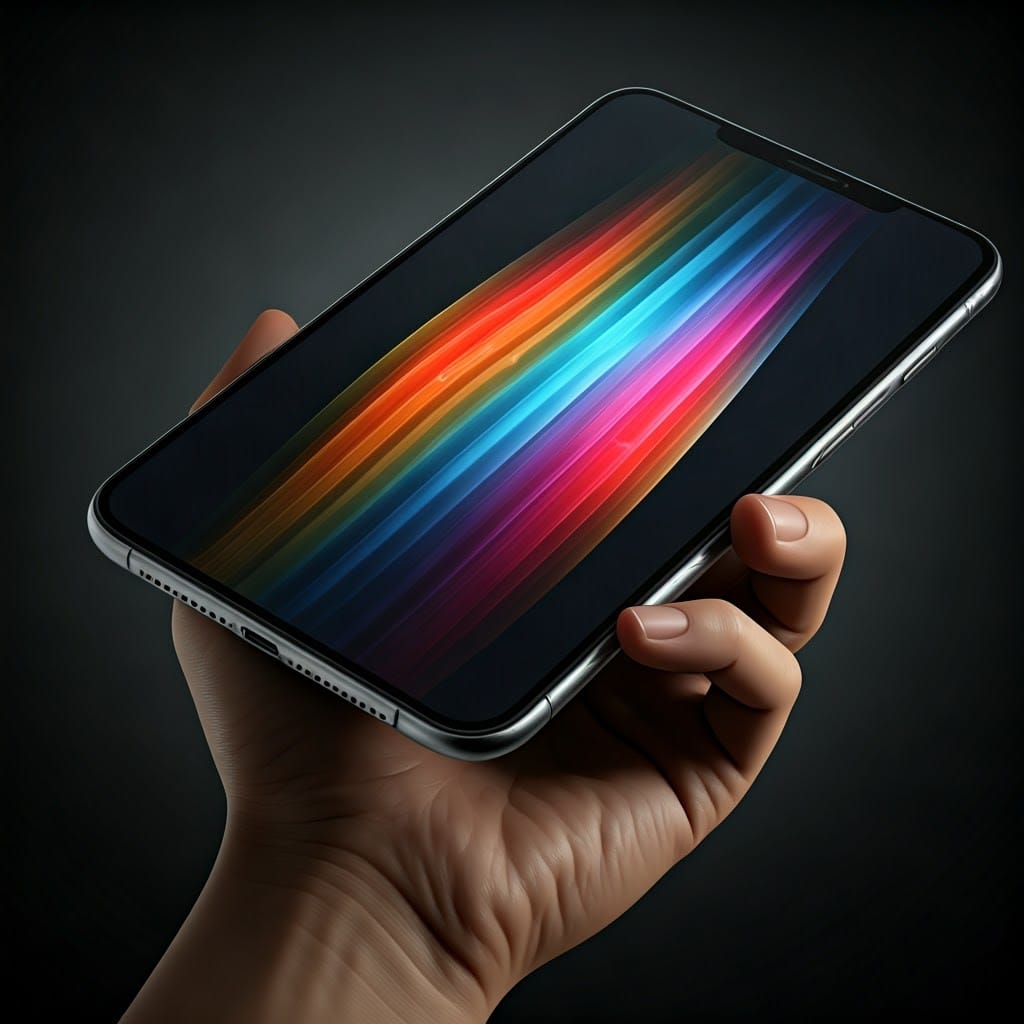In a shocking twist that absolutely no one saw coming except literally everyone with a passing interest in consumer technology, Apple plans to release its revolutionary, groundbreaking, paradigm-shifting foldable iPhone in 2026. The device, which industry insiders definitely aren’t calling the “iFold” because that would require Apple’s naming department to experience a genuine creative impulse, will arrive a mere seven years after Samsung first introduced the concept to the market. At this pace, we can expect Apple to invent teleportation approximately 45 years after everyone else has been beaming to work.
According to multiple reports that Apple has neither confirmed nor deployed black-ops teams to suppress, the foldable iPhone will feature a book-style design with a 5.7-inch outer display when closed and an approximately 8-inch screen when unfolded.1 This marks the first time in history Apple has looked at Samsung’s homework, waited half a decade, and then turned in the same assignment with slightly supposed better handwriting.
Tim Cook’s Grand Vision: Make Products Thinner Until They Literally Disappear
The foldable iPhone will reportedly measure between 4.5mm and 4.8mm when unfolded, continuing Apple’s relentless pursuit of devices so thin they can only be seen when viewed edge-on.2 Apple engineers have apparently solved the problem of “physics” and “material strength” by creating a device that, when measured by conventional instruments, technically has negative thickness.
“Our revolutionary foldable has the structural integrity of tissue paper but costs as much as a used car,” said a Apple executive while rhythmically tapping on a MacBook made of recycled aluminum and the tears of repair technicians. “We’ve invested billions in creating a hinge so sophisticated that it will absolutely, positively not break unless you look at it wrong, breathe near it, or attempt to use it for its intended purpose.”
Industry analysts speculate that the device will incorporate titanium and stainless steel in its hinge mechanism, presumably so that when it inevitably breaks, you can melt it down and recover at least $15 worth of precious metals from your $2,500 investment.3
Apple’s Bold New Pricing Strategy: “What If We Just Charged More?”
Speaking of that price tag, multiple reports suggest the foldable iPhone will retail between $2,000 and $2,500, making it the most expensive iPhone ever and cementing Apple’s position as the only company that can convince consumers that paying mortgage-level prices for a phone is perfectly reasonable.4
“Our market research indicates that many Apple customers still have functioning kidneys, which represents an untapped revenue stream,” explained a Apple CFO while bathing in a tub of liquid cash. “The $2,500 price point was carefully calculated based on the maximum amount we can charge before people start questioning their life choices, multiplied by the blind Apple brand loyalty coefficient.”
When asked why the foldable would cost more than twice as much as the standard iPhone, the executive smiled knowingly. “We’ve added a hinge. Do you have any idea how expensive hinges are? They’re practically extinct in the wild. We had to breed them in captivity.”
The Launch Schedule Shuffle: “It’s Not Confusing If You’re Rich Enough”
In what tech journalists are describing as “a spreadsheet nightmare,” Apple plans to completely revamp its iPhone launch strategy to accommodate the foldable device. Starting in 2026, the company will release the iPhone 18 Pro models, a mysterious “Air” variant, and the foldable in fall 2026, while delaying the standard iPhone 18 until spring 2027.
This staggered release schedule – which would require an advanced degree in Apple Product Management to comprehend – is reportedly designed to “streamline” the broader six-model iPhone lineup.5 Because nothing says “streamlined” like splitting your flagship product launch across two separate seasons of the year.
“We found that having a single, easy-to-understand product launch each year was causing dangerous levels of customer satisfaction,” said a Apple marketing director. “Our new approach ensures that no matter when you buy an iPhone, you can immediately experience the crushing regret of knowing a better one is coming out in six months.”
The company’s internal research apparently shows that customer confusion leads to panic buying of the most expensive model available, in a psychological phenomenon economists call “just make it stop pricing.”
The Face ID Vanishing Act: “We Put It Under the Display Because We Can”
In addition to folding innovations, the 2026 iPhone Pro models will reportedly feature under-display Face ID technology, with the facial recognition hardware embedded beneath the screen. This breakthrough allows Apple to shrink the Dynamic Island cutout to a small pill or hole in the top-left corner, in what engineers are calling “Dynamic Peninsula” or possibly “Dynamic Archipelago” depending on which marketing focus group responds better.
“We’ve managed to hide the Face ID sensors under the display,” boasted a conjectural Apple engineer. “Not because anyone asked for it or because it meaningfully improves the user experience, but because Samsung did it and we needed something else to mention in the keynote besides the fold.”
When questioned about potential reliability issues with the hidden sensors, the engineer nodded thoughtfully. “Oh, they’ll absolutely be less reliable. But they’ll be less reliable elegantly.”
The Courage to Follow: Apple’s Bold New Direction of Going Where Others Have Been
Perhaps the most remarkable aspect of Apple’s foldable plans is the company’s breathtaking courage to follow in the footsteps of nearly every other major smartphone manufacturer. After watching Samsung, Motorola, Google, and various Chinese companies pioneer and refine foldable technology since 2019, Apple has finally decided the concept is sufficiently mature to receive the blessing of its marketing department.6
“We believe foldables represent the future of smartphones,” declared an apocryphal Apple VP of Innovation while adjusting his perfectly circular glasses. “Not the past future, which was five years ago when everyone else released them, but the future future, which is when we decide to acknowledge their existence.”
When reminded that Samsung is already on its sixth generation of foldable phones, the executive smiled thinly. “Yes, but have they charged $2,500 for one and called it ‘magical’? Checkmate!”
The iPad Division’s Existential Crisis: “We’re In Danger, Aren’t We?”
The most fascinating aspect of this development is Apple’s apparent willingness to cannibalize iPad sales, breaking with its historical approach of maintaining clear boundaries between product categories.
“For years, Apple told us touchscreen Macs would never happen because they would hurt iPad sales,” explained industry analyst Victoria Richards. “Now they are making a phone that unfolds into an iPad. It’s like watching a strict vegetarian order a 40-ounce ribeye while explaining they have always been a carnivore.”
The iPad division is reportedly in a collective state of panic. “I just got people to start using this thing for actual work instead of just watching Netflix in bed,” lamented an iPad product manager into their locally-sourced kombucha. “Now they’re going to fold a phone in half and call it an iPad killer? I should have taken that job at Microsoft.”
When asked about the potential impact on iPad sales, an Apple executive deflected. “The iFold – I mean, the foldable iPhone – creates an entirely new product category. It’s not a phone. It’s not a tablet. It’s a… phablet. Wait, no, Samsung used that name. It’s a… foldy-phone-pad-thing. Our marketing department is still workshopping it.”
The $700 Million Crease Solution: “It’s Not a Crease, It’s a Feature”
One area where Apple genuinely appears to be innovating is in solving the dreaded “crease problem” that has plagued foldable displays. Reports indicate that Apple’s foldable will feature a display that appears crease-free to the human eye, thanks to a development effort that likely cost more than the GDP of Mauritius.
“We’ve spent approximately $700 million eliminating the crease,” bragged an Apple materials scientist. “Not because it affected functionality in any meaningful way, but because it offended Jony Ive’s ghost, which still haunts our design studio despite him having left the company years ago and being very much alive.”
The solution reportedly involves a proprietary combination of ultra-thin glass, nanopolymers, and the tears of Android users who paid $1,800 for first-generation foldables that broke within a week.
The 20th Anniversary Gift: A Completely Different Philosophy
In what can only be described as cosmic timing, Apple’s second-generation foldable is set to launch in 2027 – exactly twenty years after Jobs unveiled the original iPhone. This perfect symmetry suggests either brilliant marketing or that Tim Cook has discovered time travel.
“For the 20th anniversary of the product that changed everything, we wanted to create something special,” an Apple executive might say. “So we decided to completely abandon its foundational principles and make it fold in half. It’s poetic, really.”
The irony isn’t lost on tech historians who recall Jobs’ original iPhone presentation, where he mocked other phones for having too many buttons and moving parts. Two decades later, Apple’s solution appears to be adding the most significant moving part possible: a massive hinge that transforms their sleek monolith into what is essentially two phones stuck together with industrial-strength tape.
“Steve always said the consumer doesn’t know what they want until we show it to them,” said Tim Cook’s evil twin, Jim Cook. “We’ve updated that to: The consumer doesn’t know what they want until Samsung shows it to them, they buy it, and then we make a slightly more polished version five years later and charge double.”
What do you think? Will you be mortgaging your home to purchase the Apple iFold when it arrives in 2026? Will Steve Jobs complete his transformation into a perpetual motion machine? Has Apple finally run out of ideas, or is this genuinely the next evolution of the smartphone? Comment below with your hottest takes on Apple’s bendable future.
And if this article gave you a chuckle, consider donating to TechOnion-we need the funds to develop a foldable newsletter that's thinner, lighter, and three times more expensive than reading it on your phone.

References
- https://www.tomsguide.com/news/iphone-flip-everything-we-know-about-apples-foldable-phone-plans ↩︎
- https://www.business-standard.com/technology/tech-news/apple-s-foldable-iphone-set-to-launch-in-2026-together-with-air-pro-models-125050500254_1.html ↩︎
- https://www.techrepublic.com/article/apple-foldable-iphone-rumor/ ↩︎
- https://www.macrumors.com/2025/03/24/foldable-iphone-to-launch-next-year/ ↩︎
- https://www.theverge.com/news/660739/apple-may-stagger-next-years-iphones-to-make-way-for-a-foldable ↩︎
- https://www.cnet.com/tech/mobile/iphone-flip-the-apple-foldable-could-come-by-the-end-of-2026/ ↩︎





GIPHY App Key not set. Please check settings
One Comment